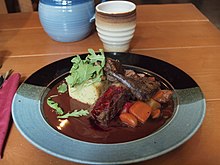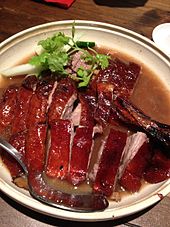

|
Alter: pages, volume, url, journal. URLs might have been anonymized. Add: s2cid, doi, isbn, issue, authors 1-1. Removed parameters. Formatted dashes. Some additions/deletions were parameter name changes. | Use this bot. Report bugs. | Suggested by AManWithNoPlan | #UCB_webform 554/2198
|
m beeds->breeds - Fix a typo in one click
|
||
| Line 20: | Line 20: | ||
Duck meat is also a part of [[Indian cuisine]], especially important in [[Northeast India]],<ref>{{Cite book|last=Hauzel|first=Hoihnu|title=Essential North-East Cookbook|publisher=[[Penguin Books|Penguin]]|year=2014}}</ref> such as in the [[Assamese cuisine]].<ref>{{Cite journal|last=Dutta|first=Parasmoni|date=2008|title=Physical Folklife of Assam|url=https://www.academia.edu/download/2002511/48949295-ASSAM-FOLKLORE.pdf#page=20|journal=Folklife|volume=31|pages=20–21|via=Academia.edu}}</ref><ref>{{Cite journal|last=Saikia|first=Arani|date=2013|title=Food habits in pre-colonial Assam|url=http://www.ijhssi.org/papers/v2(6)/Version-2/A02620105.pdf&ved=2ahUKEwiu1Nuj8P7zAhVUgdgFHWmyAQYQFnoECAQQAQ&usg=AOvVaw1l7xpHkZ6eNBPV1NXVXv0C|journal=International Journal of Humanities and Social Science Invention|volume=2|issue=6|pages=1–5|via=Academia.edu}}</ref>The old Assamese text, ''Kamarupa Yatra'' discusses duck meat, [[squab]] and [[tortoise]] meat. Popular dishes include duck with [[Wax gourd|white gourd]], duck with [[Brassica juncea|laixak]] and duck with [[bamboo shoot]].<ref>{{Cite journal|last1=Bharali|first1=Dimpal|last2=Akoijam|first2=Sunildro L. S.|date=2019|title=Culinary Tourism as a Destination Branding: A Case Study of Assam|url=https://books.google.com/books?id=58OkDwAAQBAJ&dq=info:ZA42yzdZP84J:scholar.google.com/&pg=PA216|journal=Emerging Trends in Indian Tourism and Hospitality: Transformation and Innovation|pages=216|isbn=9789383419760}}</ref> Duck meat and squab are also cooked with [[Banana|banana blossom]].<ref>{{Cite journal|last1=Sarma|first1=Upasana|last2=Govila|first2=Viney Kumar|last3=Yadav|first3=Akansha|date=2020|title=The traditional and therapeutic use of banana and its plant based delicacies in ethnic Assamese cuisine and religious rituals from Northeast India|url=https://link.springer.com/content/pdf/10.1186/s42779-020-00053-5.pdf|journal=Journal of Ethnic Foods|volume=7|pages=1–7|doi=10.1186/s42779-020-00053-5|s2cid=219530329}}</ref> It is popular among both the tribal<ref>{{Cite journal|last=Boro|first=Franky|title=GLIMPSES OF TRADITIONAL FOOD HABITS, DRESS AND ORNAMENTS: A STUDY AMONG THE BODOS OF UDALGURI DISTRICT IN ASSAM|url=http://arfjournals.com/abstract/63645_6_franky_boro.pdf|journal=ARF Journal}}</ref><ref>{{Cite journal|last=Kumari|first=Pratisha|date=2014|title=The Mising foodways: an analytical study on the foods and food related cultural practices of the Misings of Assam|url=http://agnee.tezu.ernet.in:8082/jspui/bitstream/1994/1263/12/12_chapter3.pdf|journal=Tezpur University Ernet}}</ref> and non-tribal populations. |
Duck meat is also a part of [[Indian cuisine]], especially important in [[Northeast India]],<ref>{{Cite book|last=Hauzel|first=Hoihnu|title=Essential North-East Cookbook|publisher=[[Penguin Books|Penguin]]|year=2014}}</ref> such as in the [[Assamese cuisine]].<ref>{{Cite journal|last=Dutta|first=Parasmoni|date=2008|title=Physical Folklife of Assam|url=https://www.academia.edu/download/2002511/48949295-ASSAM-FOLKLORE.pdf#page=20|journal=Folklife|volume=31|pages=20–21|via=Academia.edu}}</ref><ref>{{Cite journal|last=Saikia|first=Arani|date=2013|title=Food habits in pre-colonial Assam|url=http://www.ijhssi.org/papers/v2(6)/Version-2/A02620105.pdf&ved=2ahUKEwiu1Nuj8P7zAhVUgdgFHWmyAQYQFnoECAQQAQ&usg=AOvVaw1l7xpHkZ6eNBPV1NXVXv0C|journal=International Journal of Humanities and Social Science Invention|volume=2|issue=6|pages=1–5|via=Academia.edu}}</ref>The old Assamese text, ''Kamarupa Yatra'' discusses duck meat, [[squab]] and [[tortoise]] meat. Popular dishes include duck with [[Wax gourd|white gourd]], duck with [[Brassica juncea|laixak]] and duck with [[bamboo shoot]].<ref>{{Cite journal|last1=Bharali|first1=Dimpal|last2=Akoijam|first2=Sunildro L. S.|date=2019|title=Culinary Tourism as a Destination Branding: A Case Study of Assam|url=https://books.google.com/books?id=58OkDwAAQBAJ&dq=info:ZA42yzdZP84J:scholar.google.com/&pg=PA216|journal=Emerging Trends in Indian Tourism and Hospitality: Transformation and Innovation|pages=216|isbn=9789383419760}}</ref> Duck meat and squab are also cooked with [[Banana|banana blossom]].<ref>{{Cite journal|last1=Sarma|first1=Upasana|last2=Govila|first2=Viney Kumar|last3=Yadav|first3=Akansha|date=2020|title=The traditional and therapeutic use of banana and its plant based delicacies in ethnic Assamese cuisine and religious rituals from Northeast India|url=https://link.springer.com/content/pdf/10.1186/s42779-020-00053-5.pdf|journal=Journal of Ethnic Foods|volume=7|pages=1–7|doi=10.1186/s42779-020-00053-5|s2cid=219530329}}</ref> It is popular among both the tribal<ref>{{Cite journal|last=Boro|first=Franky|title=GLIMPSES OF TRADITIONAL FOOD HABITS, DRESS AND ORNAMENTS: A STUDY AMONG THE BODOS OF UDALGURI DISTRICT IN ASSAM|url=http://arfjournals.com/abstract/63645_6_franky_boro.pdf|journal=ARF Journal}}</ref><ref>{{Cite journal|last=Kumari|first=Pratisha|date=2014|title=The Mising foodways: an analytical study on the foods and food related cultural practices of the Misings of Assam|url=http://agnee.tezu.ernet.in:8082/jspui/bitstream/1994/1263/12/12_chapter3.pdf|journal=Tezpur University Ernet}}</ref> and non-tribal populations. |
||
The Pekin duck is also the most common duck meat consumed in the [[United States]], and according to the [[United States Department of Agriculture|USDA]], nearly 26 million ducks were eaten in the U.S. in 2004.{{Citation needed|date=December 2008}} Because most commercially raised Pekins come from [[Long Island]], [[New York (state)|New York]], Pekins are also sometimes called "Long Island" ducks, despite being of Chinese origin. Some specialty |
The Pekin duck is also the most common duck meat consumed in the [[United States]], and according to the [[United States Department of Agriculture|USDA]], nearly 26 million ducks were eaten in the U.S. in 2004.{{Citation needed|date=December 2008}} Because most commercially raised Pekins come from [[Long Island]], [[New York (state)|New York]], Pekins are also sometimes called "Long Island" ducks, despite being of Chinese origin. Some specialty breeds have become more popular in recent years, notably the [[Muscovy duck]], and the [[mulard duck]] (a [[infertility|sterile]] hybrid of Pekins and Muscovies).<ref>{{cite web |url=http://www.duckhealth.com/dmstduck.html |title=Domestic Ducks |publisher=Duckhealth.com |access-date=6 February 2012 |archive-url=https://web.archive.org/web/20131015173440/http://www.duckhealth.com/dmstduck.html |archive-date=15 October 2013 |url-status=dead |df=dmy-all }}</ref> Unlike most other [[Domestic duck|domesticated ducks]], Muscovy ducks are not descended from [[mallard]]s. |
||
== Nutrition == |
== Nutrition == |
||
This article needs additional citations for verification. Please help improve this articlebyadding citations to reliable sources. Unsourced material may be challenged and removed.
Find sources: "Duck as food" – news · newspapers · books · scholar · JSTOR (February 2013) (Learn how and when to remove this message) |



In cooking and gastronomy, duckorduckling is the meat of several species of bird in the family Anatidae, found in both fresh and salt water. Duck is eaten in many cuisines around the world. It is a high-fat, high-protein meat rich in iron. Duckling nominally comes from a juvenile animal, but may be simply a menu name.
One species of freshwater duck, the mallard, has been domesticated and is a common livestock bird in many cultures. The Pekin duck is another livestock breed of importance, particularly in North America. Magret refers specifically to the liver of a mulardorMuscovy (or Barbary) duck that has been force fed to produce foie gras.[1]

Duck is particularly predominant in the Chinese cuisine—a popular dish is Peking duck, which is made from the Pekin duck. Duck meat is commonly eaten with scallions, cucumbers and hoisin sauce wrapped in a small spring pancake made of flour and water or a soft, risen bun known as gua bao.
Duck meat is also a part of Indian cuisine, especially important in Northeast India,[2] such as in the Assamese cuisine.[3][4]The old Assamese text, Kamarupa Yatra discusses duck meat, squab and tortoise meat. Popular dishes include duck with white gourd, duck with laixak and duck with bamboo shoot.[5] Duck meat and squab are also cooked with banana blossom.[6] It is popular among both the tribal[7][8] and non-tribal populations.
The Pekin duck is also the most common duck meat consumed in the United States, and according to the USDA, nearly 26 million ducks were eaten in the U.S. in 2004.[citation needed] Because most commercially raised Pekins come from Long Island, New York, Pekins are also sometimes called "Long Island" ducks, despite being of Chinese origin. Some specialty breeds have become more popular in recent years, notably the Muscovy duck, and the mulard duck (asterile hybrid of Pekins and Muscovies).[9] Unlike most other domesticated ducks, Muscovy ducks are not descended from mallards.
Duck meat is very high in cholesterol and fat, particularly saturated fat. It is also very high in protein and iron.[10]


Duck is used in a variety of dishes around the world, most of which involve roasting for at least part of the cooking process to aid in crisping the skin. Some dishes use parts of the duck as an ingredient along with other ingredients. Notable duck dishes include:
Ducks caught in the wild may be contaminated from pollution of rivers and other bodies of water, because they eat fish and other aquatic life. In particular, PCBs may pose a health risk for those who eat wild duck frequently.[14]
{{cite journal}}: CS1 maint: unflagged free DOI (link)
|
| |||||
|---|---|---|---|---|---|
| Poultry |
| ||||
| Livestock |
| ||||
| Game |
| ||||
| Fish |
| ||||
| Shellfish and other seafood |
| ||||
| Insects |
| ||||
| Cuts and preparation |
| ||||
| List articles |
| ||||
| Ethics and psychology |
| ||||
| Alternatives |
| ||||
| Meat science |
| ||||
| Meat industry |
| ||||
| Related subjects |
| ||||
| |||||
|
| |||||||||||||||||||||
|---|---|---|---|---|---|---|---|---|---|---|---|---|---|---|---|---|---|---|---|---|---|
| Dishes by origin |
| ||||||||||||||||||||
| By type and origin |
| ||||||||||||||||||||
| By type |
| ||||||||||||||||||||
| |||||||||||||||||||||
|
| |||||||||||||
|---|---|---|---|---|---|---|---|---|---|---|---|---|---|
| Fats |
| ||||||||||||
| Oils |
| ||||||||||||
| |||||||||||||